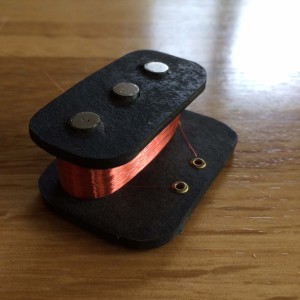Making A Single Coil Pickup
 It’s probably a bit premature to put this up, but I’m so excited that it “looks” like a pickup that I’m posting this before I know whether it actually “works” like a pickup! This is the first time I’ve ever tried making a single coil pickup – or any kind of pickup! – so to get this far is worth celebrating.
It’s probably a bit premature to put this up, but I’m so excited that it “looks” like a pickup that I’m posting this before I know whether it actually “works” like a pickup! This is the first time I’ve ever tried making a single coil pickup – or any kind of pickup! – so to get this far is worth celebrating.
This is part of the build process for a series of “custom box guitars” that I’m working on – basically a cigar box guitar with a box that looks a bit more like a classic guitar than something cigars came in. On the first one I built – making just a standard square box – I used a piezo pickup that worked quite well. But I wanted to get a normal pickup into the mix. When I mentioned this to my mate Aaron he texted back three words that he knew I wouldn’t be able to resist: Make your own.
So started several hours of research seeing what I could uncover online about how the hell I would actually do this. Because it’s just a three-string guitar I knew I would have to start from raw materials as there weren’t any three-pole bobbins available. Parts were easy enough to get from Stew Mac: some “flatwork” for the tops and bottom of the bobbin, a spool of 42AWG wire, some alnico 5 magnets for the poles, and a pack of the little eyelets for attaching the wire. Actually making the bobbin was challenging as there really isn’t anywhere I’ve found that shows you how – there’s lots of information on people making pickups with pre-drilled flatwork but nothing from scratch. Without a drill press, I drilled holes by hand and managed to get them reasonably well lined up, but they were a little small and required some well place hits with a hammer to sit the magnets in place. Whether this hammering will have affected the magnets I don’t know yet! Next time I think I’ll drill slightly larger holes and then get the magnets to be secure using a dab of superglue.
 Winding was always going to be the biggest challenge. Again, lots of people use old sewing machines, and I was lucky enough to have one at hand. I attached the bobbin to the end with a piece of heavy-duty double-sided tape, did a few manual wraps, then slowly pressed on the foot-controller to get it spinning… and it worked! I was worried that I might snap the wire – it’s incredibly thin – so was surprised about how sturdy the wire actually was. Of course to do this right I should have had a counter to actually work out how many wraps I’d done (somewhere between 5000-8000 seems to be the go) but without that I had to just eyeball it.
Winding was always going to be the biggest challenge. Again, lots of people use old sewing machines, and I was lucky enough to have one at hand. I attached the bobbin to the end with a piece of heavy-duty double-sided tape, did a few manual wraps, then slowly pressed on the foot-controller to get it spinning… and it worked! I was worried that I might snap the wire – it’s incredibly thin – so was surprised about how sturdy the wire actually was. Of course to do this right I should have had a counter to actually work out how many wraps I’d done (somewhere between 5000-8000 seems to be the go) but without that I had to just eyeball it.
Once I get leads soldered on to it I’ll be able to see how it works – so stay tuned. And in the meantime, here’s a sneak peak of how the Custom Box Guitar project is progressing. There will be a more detailed post about it once I’m finished.


